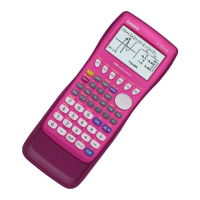183
P.117
13-2 Storing, Editing, and Selecting Dynamic
Graph Functions
In addition to the seven built-in functions, you can input 20 of your own Dynamic
Functions. Once a function is stored in memory, it can be edited and selected
when needed for graphing.
All of the procedures you need to use for storing, editing, and selecting Dynamic
Graph functions are identical to those you use in the GRAPH Mode. For details,
see “8-3 Graph Function Operations”.
•Dynamic Graphs can be one of the following three types only: rectangular
coordinate (Y=), polar coordinate (r=), and parametric.
•You cannot use Dynamic Graph with X=constant or inequality graphs of
functions stored in the GRAPH or TABLE Mode.
• If you try to use Dynamic Graph with a function that does not contain a
variable, a “No Variable” error occurs. If this happens, press A to clear the
error.
•Dynamic Graph always uses blue to draw graphs. This cannot be changed.
CFX

